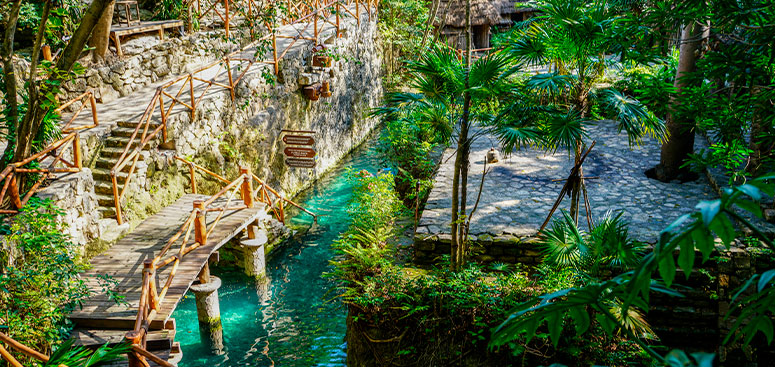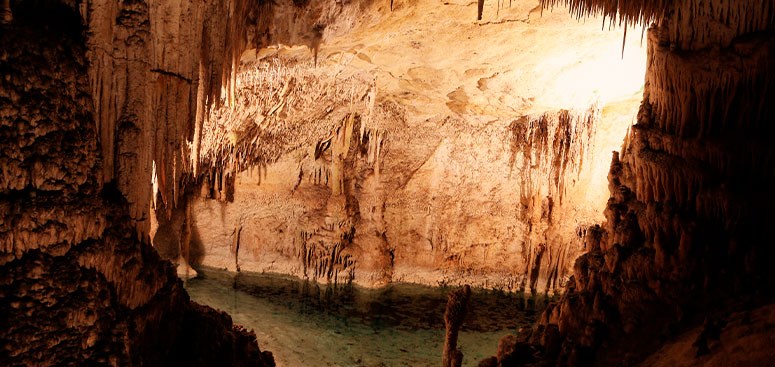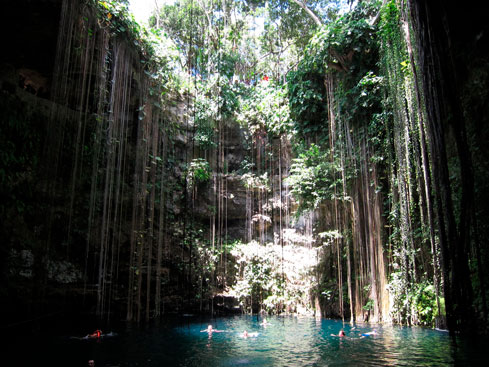Cenotes, the jewel of the Mexican

Beautiful, but full of mystery and magic at the same time, the cenotes are the most beautiful jewels of the Peninsula. Cenotes are deep water wells, which are fed by the filtration of rain and by the currents of the rivers that are born in the heart of the earth. That is why when swimming in a cenote you feel so fresh, imagine that the average temperature of its waters is a maximum of 24°C!
Beautiful, but full of mystery and magic at the same time, the cenotes are the most beautiful jewels of the Peninsula. Cenotes are deep water wells, which are fed by the filtration of rain and by the currents of the rivers that are born in the heart of the earth. That is why when swimming in a cenote you feel so fresh, imagine that the average temperature of its waters is a maximum of 24°C!
These wells owe their name to the Mayans, who baptized them with the word Dz'onot, which means "cavern with water" and from there it derived its current name cenotes.
We can say that, in a few words, a cenote is a body of groundwater that is located deep in a cave or cavern and has been formed in a totally natural way. Another characteristic of the cenotes is that the water of these formations is near the hole of the cave or cavern, so a certain amount of light enters, which facilitates vegetation and some animals.
The formation of a cenote occurs in a totally natural way through the processes of dilution of calcium carbonate rocks by the action of carbonic acid from the rains, in addition to having a great influence on its formation the passage of the waters that pass underground or underground. The rocks wear out and form vaults until the moment in which the roof of these becomes thinner and ends up collapsing, leaving the flooded part totally or partially exposed.

Cenotes can be classified according to one characteristic or another. Hall (1936) proposed a classification of the different types of cenotes according to their shape:
- Cenotes shaped like a glass and small opening.
- Cenotes with vertical walls, glass shape and large opening.
- Cenotes with sloping walls that reach a shallow pool.
- Cenotes cave with the presence of a side entrance that descends until you reach a chamber with water inside.
However, the different types of cenotes can also be classified depending on the age of the same:
- Cenotes in the open sky, being the oldest to be fully exposed.
- Semi-open cenotes, being those of intermediate age.
- Cenotes in grotto or underground, being the youngest because they still retain the roof.
The cenotes for the Mayan culture since the Pre-Hispanic Era have been a symbol of duality, since they represented life and death. That is why the ancient Mayan cities settled in their vicinity, and the control of them strengthened the power of the rulers and their great Mayan cities.
Just as they were a symbol of life, the cenotes for the Maya also represented the gateway to the world of the dead: the Xibalbá. This world was visualized beyond the groundwater and the caverns were the beginning of this path, in the same way various ritual ceremonies are performed, of which there are also vestiges.
The first official record of these ceremonies is in the Popol Vuh. The Aluxes, caretakers of the jungle and the cenotes, deserve a very important mention. Even these days, rituals and offerings are dedicated to them, learned from their Mayan ancestors, for the care of the crops, to be able to build on certain lands, and to request their permission before entering a cenote.
The six most impressive cenotes in Mexico

- Dos Ojos (Riviera Maya): With a length of 83,300 meters, it is considered among the ten longest underground river systems in the world and is a favorite for diving. When you arrive here you will find a huge cave with turquoise waters and a pier.
- Gran Cenote (Riviera Maya): Probably the most famous in the area. With a curious crescent shape, it is ideal for snorkeling along the cave system, as well as for diving among fish. Its waters extend in such a way that you can swim in the open sky or under the shelter of stalactites, where you will notice a hundred bats sleeping.
- Ik Kil (Yucatan Peninsula): It has one of the most impressive entrances because, upon arrival, you will only see a huge hole in the earth surrounded by flowers and lianas. In the background you will see people swimming in dark waters, while stone stairs descend to a pier. 4 km away is the Sacred Cenote which, it is said, connects with the Pyramid of Kukulcan.
- Cenote Azul (Riviera Maya): With almost 30 meters deep, it is perfect for those who want to swim among fish or test their skill in diving. In the surroundings you will find more cenotes, such as Cristalino and Jardín del Edén, one of the most beautiful in the region. Of course: do not be surprised if suddenly an iguana accompanies you while sunbathing, since they live in the surroundings.
- Dzitnup (Yucatan Peninsula): Also called Xkekén, it is an impressive cenote, especially at noon when the sun's rays create an insurmountable visual effect. In its waters you can see black fish that go into the depths.
- Cristal y Escondido (Riviera Maya): Cristal is a small cenote, but that doesn't diminish its beauty. It is outdoors, surrounded by palm trees, turtles and toucans. In the same park is Cenote Escondido although, as its name implies, it is somewhat complicated to reach it because they must enter the jungle and walk among rocks and branches. However, it will be worth it when you can jump into its waters from a rope or explore its underground cave.
References:
The Cenotes - Information and Characteristics
The 6 most impressive cenotes in Mexico - Mexico Unknown


